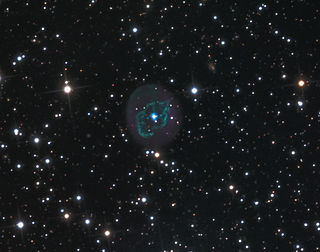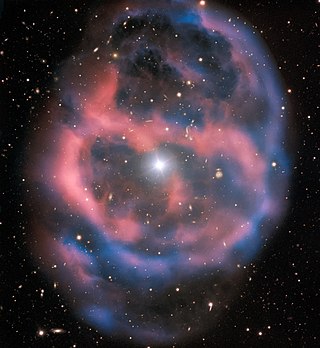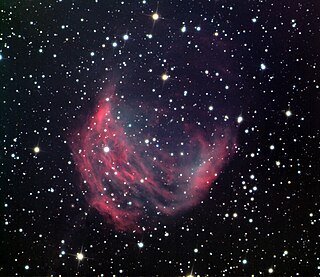
A planetary nebula is a type of emission nebula consisting of an expanding, glowing shell of ionized gas ejected from red giant stars late in their lives.

The Helix Nebula is a planetary nebula (PN) located in the constellation Aquarius. Discovered by Karl Ludwig Harding, most likely before 1824, this object is one of the closest of all the bright planetary nebulae to Earth. The distance, measured by the Gaia mission, is 655±13 light-years. It is similar in appearance to the Cat's Eye Nebula and the Ring Nebula, whose size, age, and physical characteristics are in turn similar to the Dumbbell Nebula, differing only in their relative proximity and the appearance from the equatorial viewing angle. The Helix Nebula has sometimes been referred to as the "Eye of God" in pop culture, as well as the "Eye of Sauron".

The Cat's Eye Nebula is a planetary nebula in the northern constellation of Draco, discovered by William Herschel on February 15, 1786. It was the first planetary nebula whose spectrum was investigated by the English amateur astronomer William Huggins, demonstrating that planetary nebulae were gaseous and not stellar in nature. Structurally, the object has had high-resolution images by the Hubble Space Telescope revealing knots, jets, bubbles and complex arcs, being illuminated by the central hot planetary nebula nucleus (PNN). It is a well-studied object that has been observed from radio to X-ray wavelengths. At the centre of the Cat's Eye Nebula is a dying Wolf Rayet star, the sort of which can be seen in the Webb Telescope's image of WR 124. The Cat's Eye Nebula's central star shines at magnitude +11.4. Hubble Space Telescope images show a sort of dart board pattern of concentric rings emanating outwards from the centre.

The Eskimo Nebula, also known as the Clown Face Nebula, Lion Nebula, or Caldwell 39, is a bipolar double-shell planetary nebula (PN). It was discovered by astronomer William Herschel in 1787. The formation resembles a person's head surrounded by a parka hood. It is surrounded by gas that composed the outer layers of a Sun-like star. The visible inner filaments are ejected by a strong wind of particles from the central star. The outer disk contains unusual, light-year-long filaments.

The Stingray Nebula is the youngest-known planetary nebula, having appeared in the 1980s. The nebula is located in the direction of the southern constellation Ara, and is located 18,000 light-years away. Although it is some 130 times the size of the Solar System, the Stingray Nebula is only about one tenth the size of most other known planetary nebulae. The central star of the nebula is the fast-evolving star SAO 244567. Until the early 1970s, it was observed on Earth as a preplanetary nebula in which the gas had not yet become hot and ionized.

A protoplanetary nebula or preplanetary nebula is an astronomical object which is at the short-lived episode during a star's rapid evolution between the late asymptotic giant branch (LAGB)[a] phase and the subsequent planetary nebula (PN) phase. A PPN emits strongly in infrared radiation, and is a kind of reflection nebula. It is the second-from-the-last high-luminosity evolution phase in the life cycle of intermediate-mass stars.

NGC 6751, also known as the Glowing Eye Nebula, is a planetary nebula in the constellation Aquila. It is estimated to be about 6,500 light-years away.

Mz 1 , is a bipolar planetary nebula (PN) in the constellation Norma.

Palomar 6 is a loose globular cluster in the constellation Ophiuchus that belongs to the Milky Way galaxy. It is a member of the Palomar Globular Clusters group. It is located about 25,000 light-years away from the Sun. It formed in what would become the bulge of the Milky Way. It is similar to other old-bulge globular clusters such as Messier 62, NGC 6522, NGC 6558, and Haute-Provence 1.

Abell 31 is an ancient planetary nebula in the constellation of Cancer. It is estimated to be about 2,000 light years away. Although it is one of the largest planetary nebulae in the sky, it is not very bright. The central star of the planetary nebula is a white dwarf with a spectral type of DAO. The white dwarf is the dead remains of a star that existed but had died leaving behind Abell 31 and the white dwarf.

Abell 78 is a planetary nebula located in the constellation of Cygnus at a distance of about 5,000 light years. It has a fainter halo consisting mostly hydrogen, an inner elliptical ring that is mostly made of helium and some inner knots that surround the central star and are extremely depleted in hydrogen. These inner knots were created by a very late thermal pulse, a re-ignition of thermonuclear activity in the helium shell of the star observed after the star left the asymptotic giant branch and is accompanied by strong stellar winds.

Abell 7 is a faint planetary nebula located 1800 light-years away in the constellation of Lepus. It has a generally spherical shape about 8 light-years in diameter. Within the sphere are complex details that are brought out by narrowband filters. Abell 7 is estimated to be only 20,000 years old, but the central star, a fading white dwarf, is estimated to be some 10 billion years old.

Abell 36 is a faint barrel shaped planetary nebula located 780 light years from Earth in the constellation of Virgo. It was discovered by the American astronomer George Ogden Abell in 1955.

The Abell Catalog of Planetary Nebulae was created in 1966 by George O. Abell and was composed of 86 entries thought to be planetary nebulae.

NGC 6778 is a planetary nebula (PN) located about 10,300 light years away from the Sun in the equatorial constellation of Aquila. It is positioned 5° to the SSW of the prominent star Delta Aquilae. This nebula was discovered by German astronomer Albert Marth during the period 1863–1865. English astronomer John Herschel may have mistakenly catalogued it as NGC 6785, as nothing can be found now at the coordinates he gave for it. In the New General Catalogue it was described as a "small, elongated, ill-defined disc".
LoTr 5 is a large, faint planetary nebula in the constellation of Coma Berenices. In 2018, its parallax was measured by Gaia, giving a distance of about 1,650 light-years.

KjPn 8 is a bipolar planetary nebula which was discovered by M.A. Kazaryan and Eh. S. Parsamyan in 1971 and independently by Luboš Kohoutek in 1972.

Abell 63 is a planetary nebula with an eclipsing binary central star system in the northern constellation of Sagitta. Based on parallax measurements of the central star, it is located at a distance of approximately 8,810 light years from the Sun. The systemic radial velocity of the nebula is +41±2 km/s. The nuclear star system is the progenitor of the nebula and it has a combined apparent visual magnitude of 14.67. During mid eclipse the magnitude drops to 19.24.

Abell 30 is a planetary nebula located in the constellation of Cancer, at a distance of 5,500 light years. It belongs in the rare category of born-again planetary nebulae, in which stellar activity started up again after the creation of the planetary nebula.

Abell 35, also known as Sh 2-313, is a nebula located in the constellation of Hydra, at a distance of 400 light years. The nebula is characterised by its unusual appearance, which features a central bow shock surrounded by symmetric emission. In the centre of the nebula lies a binary star, composed of a G-type star and a white dwarf. Although it is commonly referred to as a planetary nebula, it has been suggested that the nebula wasn't created by a post-AGB star shedding its outer shells but it is interstellar medium photoionised by the passing binary system, leading also to the creation of the bow shock.



















